

The four benefits of multi-channel retailing. The following is an excerpt from the free guide "Multi-channel Retailing: An Introduction," sponsored by Frank Mayer and Associates and available for download here.
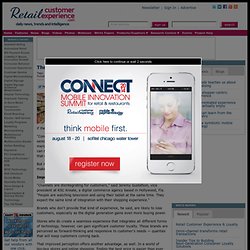
Creating a successful multi-channel experience can seem intimidating to many retailers, who may wonder if the effort is worth it. They may not have a choice, however. "Consumers are expecting this kind of integration already," said Ron Bowers, senior vice president of Frank Mayer and Associates, a Grafton, Wis. Big data's impact on retail customer loyalty. By Rob Bauder, dunnhumbyUSA For decades, business growth within the retail industry has traditionally focused on the acquisition of new customers with customer loyalty as its trusted promotional sidekick to increase store traffic and brand sales with one fell swoop.
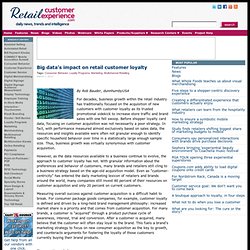
Before shopper loyalty card data, focusing on customer acquisition was not necessarily a poor strategy. In fact, with performance measured almost exclusively based on sales data, the resources and insights available were often not granular enough to identify specific household behavior over time in a statistically large enough sample size. Competitive advantage and UBER culture. Culture is often seen as the soft, 'touchy-feely' side of business.
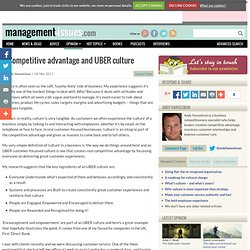
My experience suggests it's actually one of the hardest things to deal with. Why? Because it deals with attitudes and behaviours which all seem a bit vague and hard to manage. It's much easier to talk about territories, product life cycles, sales targets, margins and advertising budgets – things that are a bit more tangible. In fact, in reality, culture is very tangible. My very simple definition of 'culture' in a business is 'the way we do things around here' and an UBER customer-focussed culture is one that creates real competitive advantage by focussing everyone on delivering great customer experiences.
My research suggests that the key ingredients of an UBER culture are: 'Encouragement and empowerment' are part of an UBER culture and here's a great example that hopefully illustrates the point. I was with clients recently and we were discussing customer service. The consumer decision journey - McKinsey Quarterly - Marketing - Strategy. If marketing has one goal, it’s to reach consumers at the moments that most influence their decisions. That’s why consumer electronics companies make sure not only that customers see their televisions in stores but also that those televisions display vivid high-definition pictures. It’s why Amazon.com, a decade ago, began offering targeted product recommendations to consumers already logged in and ready to buy. And it explains P&G’s decision, long ago, to produce radio and then TV programs to reach the audiences most likely to buy its products—hence, the term “soap opera.”
Marketing has always sought those moments, or touch points, when consumers are open to influence. Interactive Exhibit 1 In the traditional funnel metaphor, consumers start with a set of potential brands and methodically reduce that number to make a purchase. Enlarge We developed this approach by examining the purchase decisions of almost 20,000 consumers across five industries and three continents. Decoding the Consumer. In the 1950’s, on the children’s live-action adventure Captain Midnight, the Secret Squadron was chartered to combat evil.
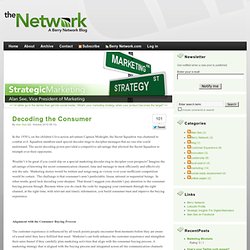
Squadron members used special decoder rings to decipher messages that no one else could understand. The secret decoding power provided a competitive advantage that allowed the Secret Squadron to triumph over their opponents. Wouldn’t it be great if you could slip on a special marketing decoder ring to decipher your prospects? Imagine the advantage of knowing the secret communication channel, time and message to most efficiently and effectively win the sale. Marketing stories would be written and songs sung as victory over your inefficient competition would be certain. Alignment with the Consumer Buying Process. Your Competitive Advantage Is Your Customers Buying Experience. We have all been through a “buying experience” that was anything but pleasant.
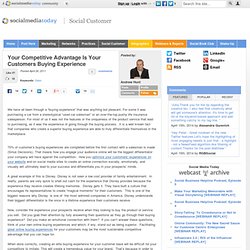
For some it was purchasing a car from a stereotypical “used car salesman” or an over-the-top pushy life insurance salesperson. For most of us it was not the features or the uniqueness of the product service that lead to purchasing, as it was the experience of going through the buying process. It is a well known fact that companies who create a superior buying experience are able to truly differentiate themselves in the marketplace. 70% of customer’s buying experiences are completed before the first contact with a salesman is made (Sirius Decisions).
That means how you engage your audience online will be the biggest differentiator your company will have against the competition. A great example of this is Disney. Now, consider the experience your prospects receive when they looking to buy the product or service you sell. Connect: Toyota Owners To Get a Private Social Network. Toyota has teamed up with Salesforce.com to create Toyota Friend, a private social network for owners of Toyota cars.
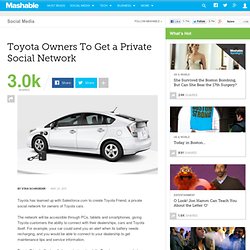
The network will be accessible through PCs, tablets and smartphones, giving Toyota customers the ability to connect with their dealerships, cars and Toyota itself. For example, your car could send you an alert when its battery needs recharging, and you would be able to connect to your dealership to get maintenance tips and service information. Branding in the Digital Age: You're Spending Your Money in All the Wrong Places.